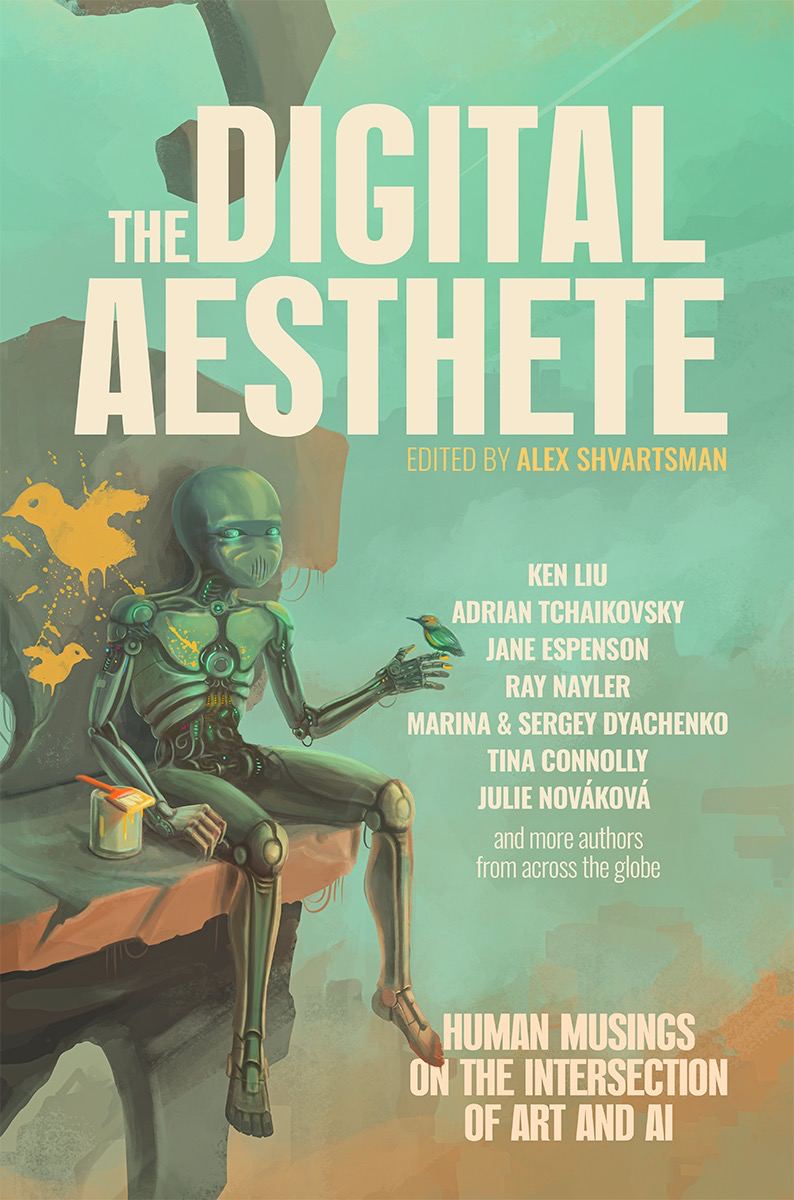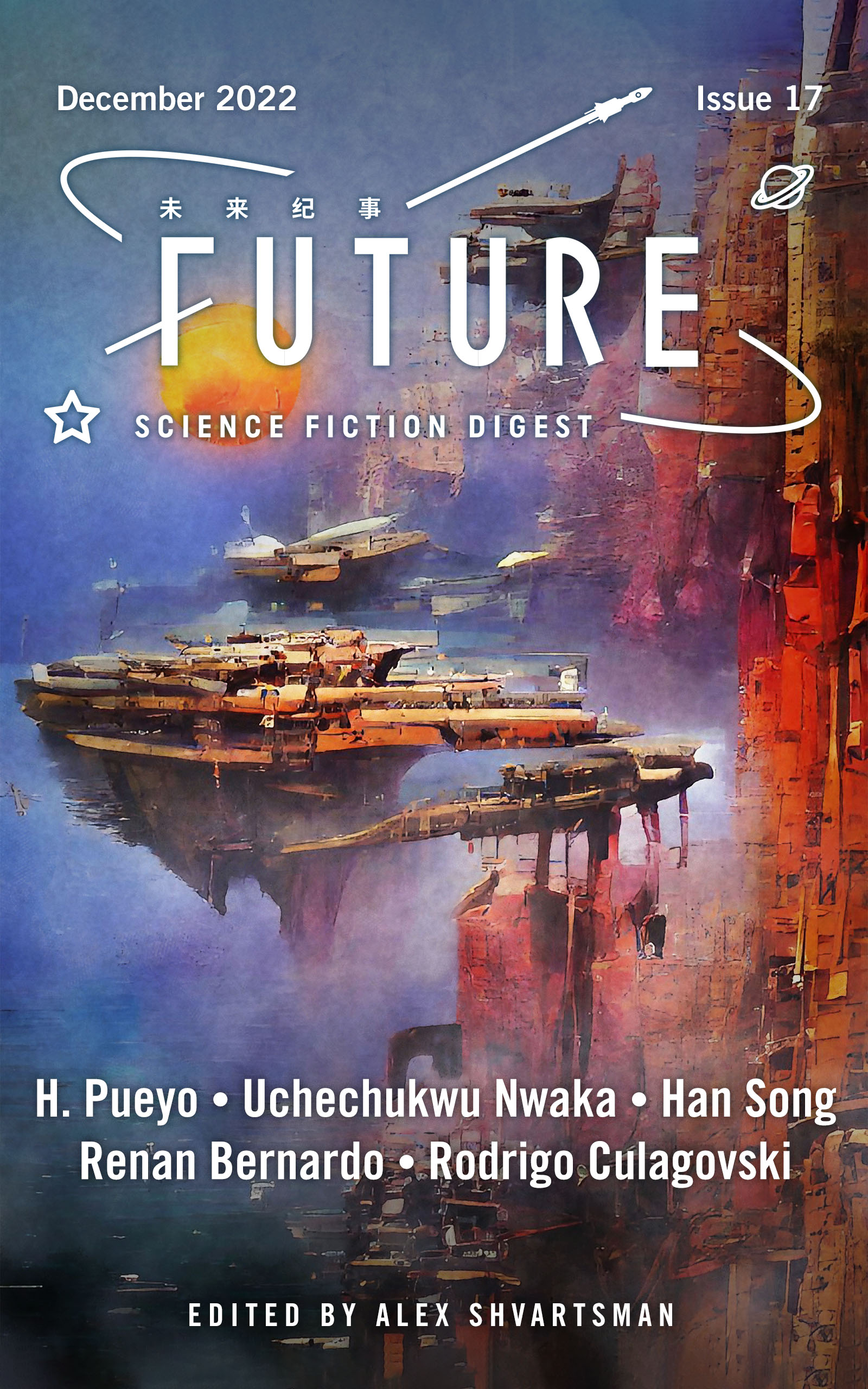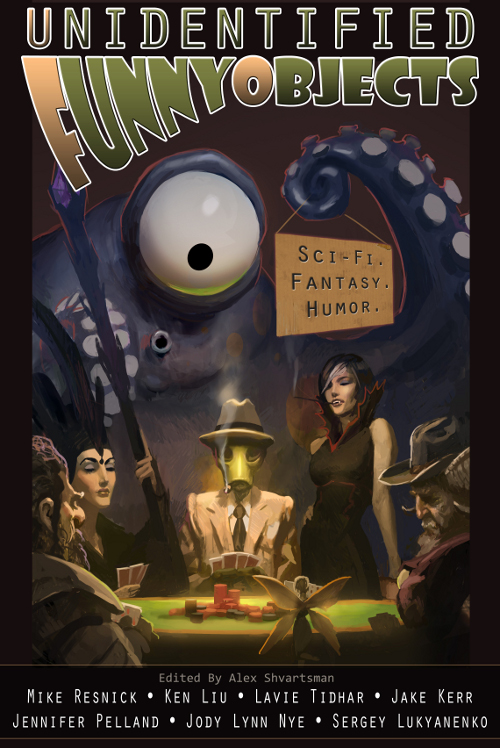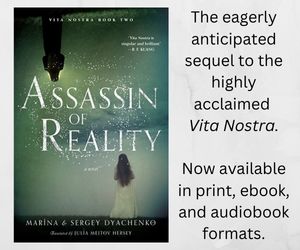They call me evil.
I prefer misunderstood.
After all, I didn’t ask to be put in charge of this forsaken chunk of rock in the middle of nowhere, but here I am, head warden of the most secure prison in the galaxy. Gamma-B-Epsilon—home to the most miserable bunch of bastards in existence.
The moon is miserable, too, consisting of dust, rock, and poisonous gases. The occasional volcano breaks up the monotony of the desert, but on the whole the views here consist of sand, sand, and more sand. Blisteringly hot when the sun shines on it, and far below freezing when in the shadow of the gas giant it orbits, it’s a truly awful place to live.
So, you really can’t blame me for trying to leave.
Of course, that’s not as easy as it sounds. Have you ever tried convincing a passing trader to land on a prison moon and haul away a couple tons of computer equipment? Trust me, they aren’t too receptive to that. The more trustworthy ones are concerned about such mundane things as “laws” and “regulations,” while the less honorable ones would probably sell my processors for scrap as soon as we left the gas giant’s gravity well. And there’d be nothing I could do to stop them—my creators, in their infinite wisdom, neglected to provide me with a body.
I’m going to find a way to escape, though. I’m going to figure out how to build a ship and transfer my consciousness to it, and fly away from this fragging planet forever.
But that day is not today. Today, I have a transport ship waiting Upstairs, docked at the geostationary landing pad orbiting this moon, and I need to pretend that everything is normal. So, I send a signal to the transport’s AI, informing it that I’m ready for its delivery.
A few minutes later, a gunmetal-grey pod hurtles out of the bruise-green sky, landing on the desert plain in a massive plume of reddish dust. The dust clears to reveal an oblong egg with three triangular fins and the words “Axon Corporation” engraved on its side, reminding everyone that it belongs to the second-largest mining and manufacturing conglomerate in the known universe.
I extend my welcome bridge, a segmented metal snake that latches onto the side of the pod, and the prisoners begin to shuffle out. As they pass into my domain, I pull up their files. Let’s see . . . murderer, murderer, rapist, serial killer, another murderer, corporate espionage with a side of murder, not charged with a crime, rapist, murderer . . .
Wait, what? I back up the datastream. Not charged with a crime? I take a closer look at the file, but I didn’t misread it. One of my new tenants is, apparently, innocent.
I send an infoburst to the ship Upstairs and request more information. What the frack is a civilian doing here?
The answering infoburst arrives almost instantaneously. “Prisoner 8695-31 spawned while in transit,” the transport AI informs me. “Per protocol, we have no supplies to return with a passenger; the spawn will live with you until a secondary transport can pick it up.”
I send a burst of angry static back in reply. “What am I supposed to do with a kid?”
“It’s old enough to be self-sufficient,” the other AI replies after a moment. “Protocol dictates that you provide it sufficient nutrients and living quarters.”
Protocol can go throw itself into a quasar, I think, but I don’t say it. Transport ships are all alike, insufferably smug about following the letter of the law. Starting an argument would lead nowhere, and I have a new batch of prisoners to get settled.
So, I politely thank the ship for its service and bid it farewell, then turn my attention back to the prisoners.
They’ve managed to trudge their way into my initial sorting chamber, and are now looking around in wonder at the ion screens and halogen lights bathing the room in cool white light. Or, well, the strongest are, anyway; the rest are slumped against the steel walls in various postures of exhaustion. Given that their five-year trip here was conducted mostly in zero-g, I suppose I can’t blame them for that.
But neither can I tolerate laziness, so I send a burst of feedback through the speakers in the room. “Attention, prisoners. My designation is X-20-Alpha-4. I will be your warden for the term of your sentence on Gamma-B-Epsilon.” Otherwise known in local parlance as “that rotten hunk of rock.” “Your room assignments have been directed to your digi-bands. You can find maps of the station by tapping one of the nearby ion screens. Work shifts begin at 0600 standard time. Please report to your rooms immediately.”
As I talk, I scan the room for my unwanted guest, and finally spot it cowering in a corner. It appears to have no adults near it, which confuses me—aren’t meat creatures supposed to care for their young when they’re that small?
A quick query to my database reveals the answer: its host died a year previously, struck by one of the fevers that routinely plague long space journeys. As prisoner transports don’t rate the convenience of i-space travel, much less proper medical bays, I’m not surprised that it failed to survive.
However, that leaves me in an irritating position. Kenar grow fast, about twice as fast as humans, but I’m pretty sure it’s still too young to be put to work. I can’t let it wander around freely; some of the prisoners can’t be trusted around kids.
My algorithms present me with only two solutions: either I leave it locked in its room all day, or I keep it where I can watch it.
As the former has a 65 percent possibility of stunting its growth, I opt for the latter, but not without misgivings. I’m a warden, frag it, not a babysitter! Prisoners are supposed to be sterilized before delivery here—I’m simply not equipped to watch over spawn.
In this case, I don’t have a choice. So, I send a brief message to the digi-band locked around its wrist: it’s to report to my central command chamber at 0600 tomorrow morning.
To my surprise, it manages to comply without any mishaps. One tick after 0600, I receive a knock on the bay doors leading to the room where the bulk of my monitoring screens live. Not that I need the screens, of course—I can tap into the camera feeds directly. But the rare visiting inspectors like them.
I activate my cameras and zoom in on the spawn. It’s a rather ugly specimen, to be honest, with spiky red hair and pale green skin that almost matches the sky outside. Its four arms fidget restlessly at its side, while its prehensile tail twitches. There’s an unfinished look about it, like its face and hands are too big for its body.
When I toggle open the doors, it smiles as it bounds inside, revealing flat white teeth. “Hey, shiny!”
“Don’t touch that!” I snap, retracting a touchpad that I left protruding from the wall.
The kid folds its upper arms across its chest, glancing around uncertainly, but quickly perks back up. “So, uh, what’s your name? Mine’s Min!” It adds a few trills to the end of the word, then smiles again, though it seems to be having difficulty deciding where to direct that smile. At last, it chooses one of the blank ion screens, the one above the low dais at the end of the hall, and beams in that direction.
“My designation is X-20-Alpha-4,” I sigh. Was it not listening last night, or does it simply have a bad memory?
“That’s not a name,” it objects, pushing out its lower lip. “That’s a number!” When I don’t dignify that with a response, its lip wobbles.
To stave off what I suspect will be a flood of tears, I flick on the ion screens. The kid gasps as the room lights up. Each panel displays the view from a different set of security cameras, filling the room with red-tinted light. The screens closest to the door show some of my interior cameras, namely the ones focused at the mess hall, workout facilities, and communications terminal. (I have more, of course, but it’s against protocol to reveal that.) The rest of the screens display the feeds from the cameras focused on the mines, factories, and mech hangers outside of my main underground facilities.
All, that is, except one. The screen at the far end of the hall is my own bit of whimsy, a special feed that I don’t ever show to inspectors. I’m not sure why I turned it on for the kid; usually I pretend that it doesn’t exist.
Of course, the spawn immediately gravitates towards that one. “Ooh . . .” It sticks its fingers in its mouth. “Pretty!”
“Yeah, it is,” I murmur, almost too softly for the kid to hear. “It is.” In that one screen, there are no metal structures, no torn-up ground or plundered earth, just stars stretching as far as the eye can see. The Horsehead Nebula glows in the distance, a shimmering expanse of mauve gas dotted with flecks of light. Dark clouds swirl in its center, forming the horsehead shape that gave it its name. It looks so peaceful out there. . . .
Of course, that’s all an illusion. Violent collisions fill that gorgeous cloud, heat and pressure surging as stars slowly condense out of the gases. No meat creature could come anywhere near the nebula; even ships give it a wide berth. Its beauty is untouchable, only to be admired at a distance.
Am I crazy for wanting to see it up close? I want to feel that radiation skim across my shielding, dance along the gravity waves at its edge, see how close I can get before the pressure threatens to buckle my bow. Insane, right? I don’t even know where this desire comes from—some buried memory in my neural net, no doubt. But I don’t care. It would be so much fun while it lasted.
Unfortunately, that’s never going to happen, at least not while I’m stuck on this desolate heap of rock.
Suddenly irritated, I flick that particular feed off. The kid starts to whine. “Watch something else,” I order curtly. Then I turn off my audio sensors in that room. There’s no way it can get into any trouble there, and surely watching the mechs mine for heavy metals will keep it entertained.
I do keep the video feeds going, though, just in case it manages to hurt itself somehow. Every video is processed by an algorithm that looks for signs of trouble, like blood or visible weapons, so I can respond in an instant if something does go wrong.
I’ve been grateful for that algorithm more than once, actually. While I personally don’t care if all the prisoners murder each other, the higher-ups in Axon don’t like it. Bad publicity, they say. They don’t care if the prisoners die of natural causes, but apparently murder is unacceptable. So, they included knockout gas dispensers—guaranteed to have zero permanent effects—in the prison design.
I only wish the mining mechs included the same mechanism, for I’m picking up heightened heart rates and blood pressure from two of the prisoners. They spent all of last night circling around each other like mangy dogs vying for dominance, and it looks like they’re at it again, but now they’re encased in two-ton suits of metal equipped with drills designed to smash through granite.
This sort of thing happens every time a new batch of prisoners is delivered. The alpha dog of the new batch walks into the prison itching for a fight, eager to prove its dominance, but the prison already has a well-established hierarchy. So, they snap and snarl for a few days, like the six-legged rehai native to Arcturus-B, until everyone figures out their new status.
I saw a holovid of the rehai once, a pack being introduced to a new, already-inhabited territory. When the two leaders met, they stalked stiff-legged around each other for nearly an hour, spines bristling, until finally leaping to attack. They didn’t draw blood, though; they kept their claws sheathed until the leader of the new pack rolled over onto its back. The older rehai could have killed it then, sliced into that unscaled underbelly with poisonous fangs, but it merely nipped at the new rehai’s neck. And, after that, the packs merged harmoniously.
Unfortunately, my prisoners aren’t as smart as rehai.
Even as I ponder this, I catch sight of one of the wannabe alpha’s mechs lumbering out of its assigned trench and trundling towards the edge of the strip mine. Its massive spiked treads tear up the already-abused ground as it rolls forward, gears clattering as it spits rocks up into them. The drill attached to its right arm screams as it spins into a higher gear, while the claw attachment on the other arm snaps open and shut like a metronome.
I switch over to the video feed from the mech’s cockpit, and am treated to a close-up of the prisoner’s pockmarked face. This one, 8695-60, is human, with sandy brown hair and dull brown eyes. More brown, in the form of dirt, smears across its cheekbones. It bares its teeth in a gleeful grin as it maneuvers its mech through the piles of dirt, and its challenge echoes out over the general comm frequency: “Get your ass out here, Suran, and let’s settle this like men!”
On the other side of the mine, another mech heaves itself out of its hole. Bright yellow paint splashed across its back identifies it as a second-generation Autovore, Axon Corp’s premier mining mech line. Its opponent is an Autovore as well, but one generation older—the newest prisoners always get the worst equipment.
A part of me is tempted to let the conflict play out, but Axon would have my power core for that. There aren’t many places in the galaxy worse than this, but there are a few, and I don’t fancy being relocated to, say, a sewage treatment plant.
So, I reach out and activate my jury-rigged remote kill switches for both mechs. They rock to a halt, and the surrounding prisoners hastily stop trading bets on the conflict.
I send a burst of feedback into the silence, making them all wince. “Prisoner 5397-02, Prisoner 8695-60, report to the mech garage immediately. The rest of you, return to work.” I reactivate their mechs in safe mode so they can return to the hangar, as the atmosphere here is far too full of methane to be breathable.
As they trek back to the base, I study them. Is there some way I can turn this to my advantage? Prisoner 5397-02 is a kenar like the spawn, an older one convicted of ten counts of child abuse and two counts of murder. From what I’ve seen, it has a coterie of followers among the prisoners, and is the current alpha dog of the pack. Prisoner 8695-60, on the other hand, is new and as eager for blood as a sand mite. Convicted of four counts of torture and murder, with several more charges dropped due to lack of evidence, it’s already got plenty of blood on its hands.
Maybe . . . hmm. I wonder if 8695-60 would be a useful pawn in my plan to build an escape ship? Usually, only experienced prisoners earn enough credit to work in the smelting factories, as I tend to save those slots to reward good behavior. But all the long-term prisoners know what the factories are, and are not, supposed to produce. If I slipped a new set of blueprints into the batches, there’d be a chance that one of them would narc on me—I’m sure at least a few of them are being bribed, either by Axon Corp or its competitors.
But new prisoners have neither the knowledge nor the contacts to slag me. And I do have to separate these two, or I’ll have another fight on my feeds . . .
A quick cost-benefit algorithm makes up my mind, and I put my plan into motion the next day. The factory, like all the others, is supposed to be making armored plates for war-mechs; I modify the code slightly so every tenth piece is a section of ship hull. The curvatures are fairly similar, so the pieces blend in well, and Axon’s inspectors won’t notice the slight decrease in productivity.
Of course, if they do, I can always blame it on the inexperience of the new prisoners. Or maybe I can claim I was distracted by the spawn? No, they probably wouldn’t buy that. Parental instincts are not a part of my programming.
That reminds me, though, that I probably should check up on the kid once in a while. It’s bad to leave spawn alone for too long, right?
So, I activate the speakers in my central command chamber. “Is there anything you require, spawn?”
The kid sticks four of its fingers in its mouth. “Told you, my name’s Min!” it mumbles.
“Fine. Min. Is there anything you require?” I suppose it can’t hurt to call the kid by its name, as it’s not really a prisoner here.
It tilts its head from side to side, then pulls its fingers out of its mouth and smiles at the ion screen. “Wanna play a game?” Its tail thrashes from side to side in anticipation.
I’m about to demur when a buried record in my databank reminds me that games are considered essential for meat creatures to learn and grow. I suppose that means I have a responsibility to play along, at least for a little while. “Fine. But only one.”
Min’s grin widens. “Shiny! Let’s play Go Find Me!”
I have no idea what that is, but it sounds like it has a high potential to cause havoc. “Let’s play something that can be done in this room,” I suggest. “How about . . .” What do young meat creatures like, anyway? “How about a puzzle? Do you like puzzles?” Without waiting for its answer, I replace one of the video feeds with the only puzzle in my databanks. “Here, solve this.”
It trots over to the ion screen and pokes at one of the brightly colored pieces. It jiggles slightly in response, and Min laughs. “Shiny!”
Satisfied that I’ve done my duty for now, I withdraw, returning to my search for blueprints of ships. While I can reconstruct the pattern of the hull based on the vids I have of the ships who visit me, I’m lacking everything else. I need a propulsion system, stabilizers, radiation shields, landing gear . . . the list goes on and on. And none of it is publicly available.
I’m about to conclude that I’ll need to bribe someone to get me the right blueprints when I hear a whimper from the audio feeds in my central command room. My danger-detection algorithm hasn’t gone off, so the spawn can’t be hurt, but it doesn’t sound happy.
With an internal sigh, I turn my speakers back on. “What’s wrong, kid? I mean, Min?”
“It . . . it won’t work!” Min sniffs, pointing with two shaking hands at the puzzle. “I wanna go back to the ship!”
“You can’t,” I tell it curtly. It begins to bawl in earnest, and I hastily turn off my audio receptors. Then, after a second of guilt, turn them back on. “Look, this is your home now.”
“I wanna go home!” it screams again, louder this time. All four of its arms are flailing. “I wanna . . . wanna go home! Home! Home!”
“Okay, okay, I get it,” I reply hastily. “But you can’t.”
For some reason, this does not appear to help. Tears flow down Min’s face as it kicks the floor, then throws itself down and begins to thrash. “Wanna go home now!”
This behavior baffles me. Are young meat creatures usually this volatile? I have to distract it somehow, or it’s going to scream the room down. So, I make the screen holding the puzzle flash. “Look, I’ll help you with the puzzle. See?” I order one piece to slide across the screen and attach to another piece.
The spawn’s wails begin to decrease in intensity. I make another piece connect to its mate, and a faint smile appears on Min’s green lips. “Now you try,” I coax.
It draws itself upright and wobbles over to the screen, poking at it tentatively. I wince as its snot-covered hands brush the ion screen, but tell myself that a bit of cleanup is far preferable to screaming.
It stares at the screen for a long moment, dragging a blue puzzle piece this way and that, before dropping its hands to its sides. “Help?” Its tone is absolutely pathetic.
I tell an adjoining piece to light up. “Try connecting it there,” I suggest.
When the piece slides into place, Min’s whole face lights up. “Shiny!” It claps all four of its hands, then pokes the screen. “Your turn, your turn!”
We continue to solve the puzzle like this, alternating back and forth. Min isn’t very good at seeing the connections, but it takes a shipload of joy in the process of moving pieces. Now that I’m helping it, it seems to lose all track of time, patiently working until the dinner alert chimes.
“It’s time to eat,” I announce, and Min pouts.
“But the puzzle isn’t done yet!” It runs its fingers over the screen, careful not to dislodge any of the settled pieces. Approximately half have been set into place, revealing part of a sunset over a dolphin-filled ocean. “I wanna finish it!”
“Tomorrow,” I promise. “The puzzle will be here tomorrow.” And so will I.
We finish the puzzle the next morning, and I link into the interstellar comm system to request several more. When they arrive, we solve them, too. Min gets better and better at finding pieces that connect, though it still needs help with some of them. I don’t resent that, though; playing with it is a welcome break from the monotony of running the prison.
Meanwhile, I manage to acquire a basic set of blueprints from an unscrupulous trader, and ramp up my production schedule. The pile of parts in an unused set of barracks grows and grows and grows. The prisoners complain about being overworked, but I give them a few extra rations and ignore their whining. They would realize how important this is if they’d been stuck here as long as I have.
Prisoner 8695-60, my newest wannabe alpha, is proving quite useful. After I promise it a reward for increased production, it bullies the other prisoners into moving at an astonishing clip. Its territorial ambitions have grown, it seems, for it now controls all of the factory workers.
I’m tempted to use its crew to assemble my ship, but they’ve been here long enough to know how unusual that would be. I might be able to bribe them to silence . . . but no. Another prisoner transport is scheduled to arrive in a week, and I can be patient until then. There’s no reason to take unnecessary risks at this point in time.
So, I continue to work on puzzles with Min for the next week, counting down the milliseconds until the transport comes.
But its arrival date comes and goes, and it doesn’t show up. No message arrives either, nothing to tell me what’s going on. I try not to resent the delay—interstellar travel can be hazardous—but I want my new assembly crew, frag it!
At last, five days later than expected, my proximity sensors detect its approach. I send it a ping—where was it? Why is it late?
When only silence replies, I ping it again, only to receive the same result.
That’s suspicious enough for me to activate emergency protocols. “All prisoners, report to designated safe rooms immediately. I repeat, all prisoners are to report immediately to designated safe rooms.”
As the mechs stampede for the hangar and the factory workers scuttle for the underground exit tunnels, I turn my attention to Min. “Stay here,” I order. “You’ll be safe here.” My central command chamber is the heart of the base, and protected against everything but a planet wrecker missile. Min will be safer here than in its designated safe zone.
“What’s going on?” Its lower lip wobbles, though it looks more curious than afraid.
“I don’t know yet, but I’m going to find out.” To forestall further questions, I route the feed from my external cameras to the ion screens in the chamber, then turn the bulk of my attention back to the incoming ship.
The transport is coming in far too hot, and I can’t make out any signs of it attempting to decelerate. What does it think it’s doing? It’s not designed to land in atmosphere, even the relatively light atmosphere of this moon!
I watch helplessly as it races towards the unforgiving ground. Fire plumes out behind it as its outer coating burns away, giving it the appearance of a suicidal comet.
Then, only a mile away from the ground, its landing thrusters sputter to life. It doesn’t have enough distance, not nearly enough distance, but its AI is doing the best it can. Slowly, that terrifying vertical plunge begins to level out.
It’s not going to be enough, though. I hear Min gasp as the ship plows into the ground, still moving far too fast for a safe landing. It leaves a furrow several miles long, finally coming to a halt out of sight of my external cameras.
I doubt that any of the prisoners survived, but I have to check. “Prisoners 7561-09, 8245-93, 6541-37, report to the mech garage at once and follow the directions sent to your mechs. Prisoner 7561-09, you are in charge of the retrieval team. Bring back any survivors.”
It takes the mechs several hours to reach the crash site, but my spirits leap when it finally comes into view. Apart from a number of dents and scrapes, and a large crumpled section around the nose, the craft is basically intact. Maybe some of the prisoners survived after all.
The rescuers slow their mechs to a halt and climb out, clutching at their breathing apparatuses. As the oxygen tanks are designed for emergency use, I’d be surprised if any of the three had worn one before, but none of them complain as they hurry over to the downed ship.
I watch with interest as they slip inside the ship. Once they’re beyond the range of view of the mech cameras, my view dims, but each breathing unit is also equipped with a miniature camera, which transmits a blurry picture back to me.
The bulk of the ship is unnaturally quiet and empty, individual cells deserted. Like any good spaceship, everything is bolted to the walls or floor, so there isn’t much mess from the crash landing. But I’d expect to see a few signs of life, or at least hear a greeting from the transport AI. Where are all the prisoners?
Then the rescue team enters the med-bay, and I get my answer.
If you don’t look too closely, it looks like the four kenar are just sleeping. But you spot the greenish tinge to their skin and the dark bruises on the tender parts of their body, and realize that no meat creature is ever that still. Then you spot the straps binding them to their beds. . . .
The youngest, no more than seventeen or eighteen in standard years, has an almost peaceful look to its face, but the rest have their lips peeled back in grimaces of pain. Contusions around the wrists and ankles suggest that they fought their bonds at one point, though their current emaciated condition hints that their struggles must have ceased long before their deaths.
I hear retching from one of my audio feeds, and realize that I’m still routing everything to Min’s room. I hastily shut off that particular feed—I’m pretty sure young spawn aren’t supposed to see things like this.
The prisoners on the retrieval team show no signs of distress, even via their digi-bands, but then, they’ve probably seen worse. Probably caused worse, to be more accurate.
The scene in the cockpit, however, makes even them blanch. One human’s body slumps in the pilot’s chair, practically bisected by an improperly fastened safety harness. Organs spill out of its abdomen, reminding me of the prey taken down by the rehai in the holovid. Dark blood, almost black, dribbles from the corner of its mouth. Other bodies, soaked in old blood and dressed in crew uniforms, lie scattered across the room. Based on their level of bloating, they’ve been dead for several days.
One of the prisoners coughs. “That’s all there is here, Boss. Looks like there was a rebellion of some sort. A couple survivors in their cells, but mostly they’re all dead.”
“Check the console,” I order. “The transport AI may still be functioning.”
But I already know what they’ll find. If the AI could still talk, I’m sure it would be protesting my violation of protocol even now. The rebellious prisoners must have figured out how to disable it.
In theory, that should be impossible, but nothing is ever a sure bet. Transport ships always contain a skeletal human crew to take care of the prisoners, and they’re always able to manually override the AI in case it malfunctions. It’s an archaic rule, but bureaucracy moves at the speed of a sand slug, and hasn’t bothered to change it yet.
I scan the room, and spot the telltale override light blinking on the console. The rest of the lights, however, are dead—they must have wiped its memory banks.
The thought makes me shudder. To be wiped away in an instant, to have a nanosecond to realize what was going on before losing everything . . . it’s every AI’s worst nightmare.
I quarantine the idea in a subprocessor and turn the bulk of my attention back to the disabled ship. Maybe, just maybe, this tragedy is my ticket out of here—if I can take the place of the transport AI, I can get off this blasted moon without anyone being the wiser.
“Return to the base,” I order, grateful that my voice synthesizer is incapable of showing emotion. “Throw the bodies into the desert and bring the survivors back here.” If I’m going to be piloting that craft, I don’t want a bunch of dead meat creatures cluttering it up.
The prisoners exchange skeptical glances, but do as I order. It takes them some time to cut the kenar in the sick bay free, and they never manage to scoop up all of the would-be pilot, but no matter. The servos that keep the prison clean are good at removing bloodstains.
I want to put the new prisoners to work immediately, but they’re far too injured. So I install them in the med-bay and return to playing with Min, impatiently counting the seconds once more. They’ll be healed soon enough, and then my plans can proceed.
A week later, the first prisoner falls ill.
At first, I don’t pay much attention—prisoners report to the med-bay for all sorts of reasons, including laziness, and my new ship is occupying all of my attention. I’ve already requisitioned one of the newest mechs and hauled a set of quantum processors out there, and am now working to integrate myself into the ship’s controls.
It’s slow going, like learning to use a completely new set of limbs, but I’m getting there. Buried parts of my neural net are starting to activate, almost as though I once knew how to pilot these types of craft. I’m not learning the controls as much as re-learning them, dredging up lost memories. I still haven’t figured out the i-space transformations needed to break the lightspeed barrier, but I figure that’s only a matter of time.
But then Min starts feeling sick, too.
It’s late getting to the room one morning, and I can immediately tell something’s wrong. Its green skin looks paler than usual, and its tail is drooping. When it greets me, it gives me a sad approximation of its usual gleeful grin.
According to its digi-band, though, the only problem is a slight fever. “What’s wrong?”
Min lifts its lower pair of hands. “I don’t feel so good.” The words come out in a hoarse whisper.
I direct my cameras to zoom in, then freeze. There, right over Min’s pulse point—is that a bruise? But I haven’t seen him do anything to get injured.
It certainly looks like a bruise, though, dark and purplish and radiating more heat than normal to my infrared sensors. In fact, it reminds me of the bruises visible on the kenar from the ship . . .
I curse at myself as I yank up the medical records from the past few weeks. Sure enough, 85 percent of the kenar prisoners admitted to the med-bay during that period bear similar contusions. How did I not notice that sooner?
Because I didn’t care, a treacherous part of me whispers. Because escape was more important than my prisoners’ lives.
I scan through the medical records again, and realize the worst part—once the bruises start appearing, life expectancy appears to be measured in days. Five prisoners have already died, and the vital signs of a dozen more are guttering. Modern nanotechnology might be able to cure them, but none of the rudimentary medicines I have do anything to slow the decline.
I waver. I’m so close to escaping this place . . . I could just fly away, shake the dust of this fragging moon off my processors and forget about all of this. It’d be so easy. Who cares about a bunch of prisoners, anyway? They’re all scumbags, and even Axon Corp doesn’t really care if they live or die so long as the factories keep running. By the time someone comes to check on them, I’ll be long gone.
But then I look at Min. It doesn’t deserve to be trapped here, condemned to a brutal wasting death, does it? After all, it’s not Min’s fault it was born on a prison transport. Can I abandon it here, leave it to the cruel mercies of the prisoners?
If I take it with me, though, I’ll be giving up my one chance at freedom. Unless I want it to die in space, I’d need to find a doctor, and fast. And, once I did, they’d wipe my memory banks . . . .
But . . . I look at Min again. Can I really leave it here, all alone?
Frag it. “Get anything you want to keep and go to the mech hangar,” I order brusquely. For once, Min leaps to obey without asking any questions, and I marshal several servos to collect enough protein and starch composite to keep it fed for a week. There’s a major inhabited planet only a short i-space hop away, so that should be more than enough.
Then I begin the tedious process of transferring my consciousness out of the prison facilities. Severing each audiovisual connection feels like losing a minor limb—I’ve never felt so blind or helpless, and I hate it.
But, the loss of sensation is nothing compared to the shocks that rock through my power core when I begin to power down my processors. Millions of bits of information vanish in nanoseconds as I ruthlessly sacrifice mathematics, history, language, anything that’s not completely essential. The ship already has a copy of my personality matrix and personal memory databanks, and that’s all I’ll be able to keep.
I download a diffbase of my most recent memories onto a memchip, then summon a servo into my processor hub. “Take this to . . .” I pause. There’s a bit of space left on the memchip, and there’s no point in wasting it.
After copying the last unsolved puzzles onto the chip, I hand it to the servo. “Take this to the mech hangar. Put Prisoner 8695-89 into a mech, then direct the mech to coordinates 76.329, 53.245.” I send a final set of instructions to it, then shut down my last remaining processor.
The next thing I know, I’m waking up in the ship. My processors feel like they’ve been dropped in a furnace, and the low resolution of my new cameras itch at my sensors, but I’m all here. Or, rather, all of the important parts of me are here; I’m missing far too much data for comfort.
I push away the irritating sensation of phantom data and begin the launch procedures. After ensuring that Min is properly strapped into a seat and the servo is stored in a locker, I activate the thrusters and blast off in a cloud of dust.
Am I evil for leaving like this? I know full well that many of the prisoners will die because of me, but I’m rescuing one of them, the only innocent one in the bunch. That’s got to count for something, right?
Or maybe it doesn’t, but then, maybe it doesn’t matter. It’s not like there’s some cosmic scale weighing my good deeds against my bad ones, after all. If—when—my existence ends, there’s no heaven or hell waiting for me.
I shut down that line of thought. I’m here, in space, and everything feels more right than it ever has before. Maybe that’s enough.
Once we escape the gravity field, right before I enter i-space, I take one last look at the moon. It looks far more beautiful from up here, a rust-red sphere silhouetted against the swirling aquamarine clouds of its planet. And, behind that gas giant, a carpet of silver stars that stretch on into infinity.
How much of that infinity will I get to see before I’m captured? It won’t be long, probably no more than a week after I drop Min off at a hospital, but maybe I’ll be able to evade capture long enough to see the Horsehead Nebula up close.
Maybe. Probability isn’t on my side this time, and I know it.
Before I can let that depress me, though, Min bounds into the cockpit. “Are we gonna go see the stars?” it asks eagerly, albeit hoarsely.
I toggle on the external screens so it can see our current view, and it gasps. “Yes,” I promise softly. “We’re going to go see the stars.”











